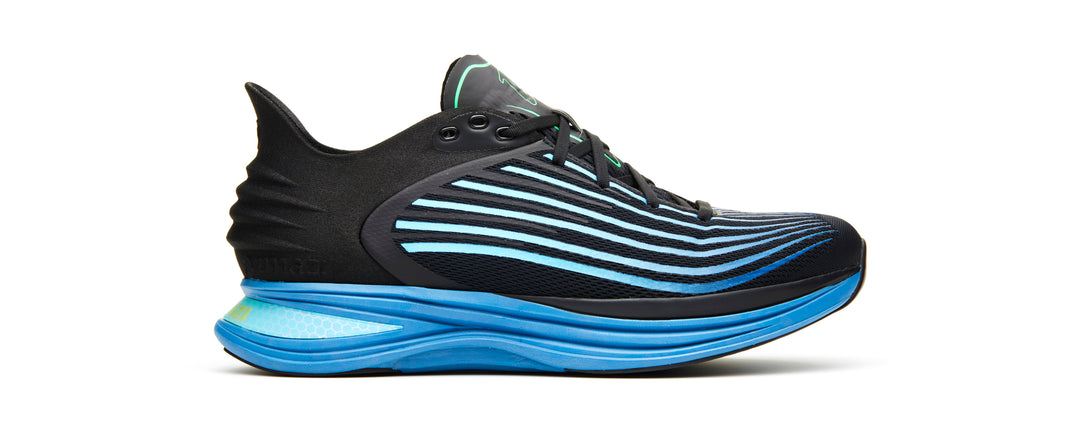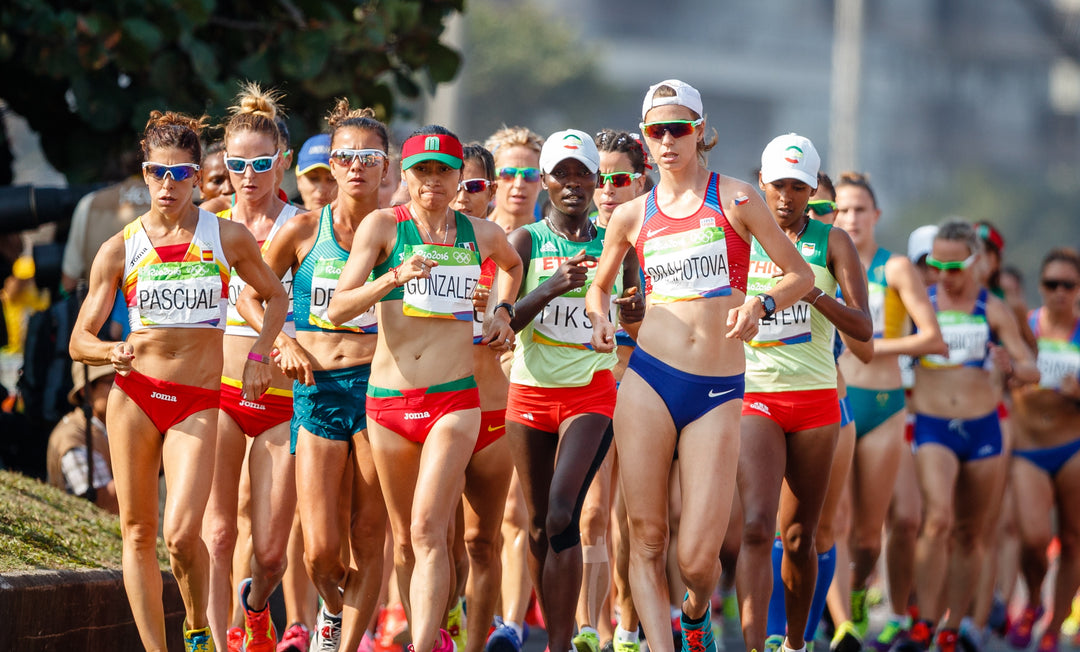Breaking the 4-Hour Marathon Barrier: Your Guide to Success
Runners care a lot about times. But come on, why should running a 3:59 marathon be such a dramatically bigger accomplishment than a 4:01 marathon? And yet it is. Breaking 4 hours in a marathon is the big goal, and we do care, passionately. So for the moment we'll set aside that grand philosophic question concerning the human psyche and the nature of time. It’s 3:59 or bust!
Breaking 4 hours in a marathon is a huge endeavor. Consider that most marathon runners finish a bit slower than 4 hours, so running faster than 4 hours puts you in the top 50% of all finishers. That’s an achievement! A marathon is also a freaking long ways. Running one off the couch is not advisable (though that hasn’t stopped everyone). Given the length and top 50% pace required, you’ll want to put in a lot of real, hard, sustained effort in preparation. Plus you need to actually run it, which is also hard.
To make sure we give ourselves some leeway, let’s train to run a 3:56 marathon, which is an even 9 minutes per mile (5:30 minutes per kilometer gets you a 3:52). So this guide is intended to get a moderately fit person—male or female—between, say, 20-45 years old to the finish line of a marathon in a few minutes under 4 hours.
Here’s the Debbie Downer caveat. It goes without saying that there are a significant number of variables that could spoil the 3:59 celebration. Marathon courses, day of race weather, quality of training, nutrition and hydration before and during the race, and sub-optimal pacing are all factors that can potentially scuttle the goal. It’s also possible that your particular body is just not going to make a 4-hour marathon happen (maybe choose a different race or less aggressive goal?). In fewer words: There are no guarantees.
In order to change this completely overwhelming project into something just whelming, let’s break up the thinking into four categories.
- High Level Tips
- Detailed Sample Training Plan
- Race Day Logistics
- Known Fast Marathons
Breaking a 4-Hour Marathon: High Level Tips
The quest to break the 4-hour marathon barrier is an endeavor that blends giddy anticipation and ongoing challenge and a couple dollops of crazy. Achieving this goal demands meticulous planning, unwavering commitment, and a steadfast mindset. Whether you're a seasoned marathoner or stepping up to the marathon starting line for the first time, this comprehensive guide is your roadmap to conquering the 26.2-mile distance and crossing the finish line under 4 hours.
Embracing the Sub-4-Hour Goal
Before embarking on this monumental feat, pause and have a heart-to-heart discussion with yourself. Do you really want to spend the next six months training for a marathon. There are lots of other goals that can get you into great shape but that require less time, energy, and potential heartbreak. Is a long run every weekend something you really want to sign up for? If yes, then ask yourself about the 4-hour goal. How meaningful is a 3:59 or faster marathon for you? Because there’s a big difference in planning, training, and mindset between breaking 4 hours and just finishing the race. Just asking questions here! If the answer is still YES, then it’s time to enthusiastically embrace the necessary effort and dedication to come.
Wait, is this realistic?
How do you know if running a 4 hour marathon is even realistic? One rule of thumb is that you should be able to run a half marathon faster than 1:50 or a 10K faster than 50 minutes either during your foundational training or early during the first half of your official 16-week training block. Before your marathon training block starts, you should be able to run for at least an hour without stopping. If you can’t currently hit these benchmarks, then you might consider changing your near-term goal. Here’s a finish time predictor that can be helpful.
The commitment, at minimum, is five workouts per week for the last 12 weeks of your marathon buildup, and one of those days needs to be a long run.
9 Minutes per mile
To achieve the goal, you'll need to maintain an average pace of approximately 9:09 per mile (5:36 minutes per kilometer) for the entire race distance. As mentioned above, you should plan on running an even 9 minutes per mile (5:30 min/km) to give yourself a buffer. Also, I can tell you from experience that it’s a lot easier to count by 9s (or 5:30s) than by 9:09s. The objective is within your reach, provided you put in the necessary work. But what’s a 9-minute mile feel like? You need to know because running the first couple miles at 7:45 min/mile is a great way to discard your goal into the trashbin of poor preparation. I myself have tossed many things into that particular bin, and it almost never feels like a win.
Get a Garmin watch, Apple Watch, FitBit or some other device and start keeping track of your pace. As explained below, your training will involve some running faster than race pace and some slower, but you’ll want to do a fair amount at race pace. I like running on a treadmill once a week because it really helps dial in a specific pace.
Establish a Fitness Foundation First
Prior to delving into a formal training plan like the one below, it's paramount to lay down a sturdy foundation of fitness. This entails engaging in a balanced mix of easy runs, extended long runs, and cross-training activities such as cycling, swimming, or hiking. You need this foundation before you begin your formal marathon training.
Make a Training Plan
Develop a comprehensive training plan that aligns with your sub-4-hour marathon objective. I recommend a 16-week plan, though some will say 12 weeks is fine while others say it has to be 20 weeks. The running will very gradually increase in mileage, which reduces the risk of overuse injuries. A lengthier training plan accommodates unforeseen circumstances and ensures more gradual progress. The 16-week plan below is a good place to start.
Week-by-Week Training Blueprint
I like to include running sessions, strength training, core workouts, plus active stretching. Aim for 4 to 5 running days per week, but make sure there’s plenty of recovery time. As you increase mileage week over week, try to stick to the traditional guideline of a maximum 10% bump in mileage from one week to the next. The marathon plan below never jumps more than 10%.
Consistency and Recovery
It’s hard to overemphasize this: Consistent training over the entire block while prioritizing adequate recovery is the crucial combo. Make sure to really rest on your rest days to prevent burnout and optimize performance. Sometimes it’s good to take a random day off running if you feel worn down. And it goes without saying that proper nutrition, hydration, and sufficient sleep are also a key ingredient to your training journey, though these items aren’t included in the plan.
Long Runs and Fast Runs Make the Difference
Long runs constitute a cornerstone of marathon preparation. In your plan, you’ll want to gradually extend your long run distances to acclimate your body to the demand of running 26.2 miles. To break 4 hours you’ll also want to integrate tempo runs and speed workouts. They work to elevate your race pace and increase endurance. Include at least one faster run each week, maintaining a challenging pace for an extended duration. Speed workouts prepare you for race day demands and increase mental toughness.
Speaking of Mental Resilience
Cultivate mental fortitude through visualization, positive affirmations, and goal-setting. Training for and running a marathon necessitate mental strength; honing these skills builds motivation and increases focus on your sub-4-hour goal.
There are physical injuries that are, unfortunately, part of the landscape. Make sure you know when to stop and recover. There’s always a marathon next year. Similarly, attitude injuries can be devastating. Do your best to stay positive, fresh, and motivated throughout your training block. Studies have shown that runners who smile—despite race-day pain or hard training—perform better. So keep smiling!
The Vimazi Z60: Best Shoe for a 4-Hour Marathon
The Vimazi Z60 is designed and engineered to perform best between 8-10:30 minutes per mile (5-6:30 min/km). You might notice that 9 min/mile is basically the middle of the pace zone, giving you better cushioning, more stability, and increased efficiency.
The rearfoot of the Z60’s midsole has been specially tuned to respond to the impact forces in that pace zone. This means you get optimized shock dampening for the runner you are—reduced shock on your body over months of training and racing is the Holy Grail for running shoes, and you can only get it in a pace-tuned shoe.
The FastPod midsole in the forefoot of the Z60 is tuned to increase efficiency during your push-off phase. Better efficiency on every stride over miles of racing will save calories, potentially allowing you to run faster. Most shoes have the same density of foam in the rearfoot and forefoot. In those shoes, good cushioning on impact means an unstable, less efficient push-off or if you get good efficiency, those shoes won’t cushion the shock as well. Tuning by pace zone and between rearfoot and forefoot is the only way to get both personalized max cushioning and max propulsion efficiency. With excellent torsional rigidity, the forefoot FastPod also helps stabilize your push-off. This adds to the efficiency as well as the health benefit.
If you really want to hit your goal of breaking 4 hours in the marathon, you owe it to yourself to try out the only shoe that’s made specifically for a 4-hour marathon pace.
Running a 4-Hour Marathon: Sample Training Plan
Here's a detailed 16-week marathon training plan tailored for an average runner aiming to break the 4-hour marathon barrier. This plan includes a mix of running workouts, cross-training, rest days, and gradually increasing mileage to help you achieve your goal.
Before Starting: Make sure you have a solid base of running fitness, including being able to comfortably run 15-20 miles per week with a long run of at least 8 miles. If you're new to marathon training and older than 35, you may want to check with your doctor before tackling a marathon.
Let’s define the types of workouts that are included in the marathon training plan below.
Easy Run - As the name implies, these runs should feel very easy (though don’t forget that some days even an easy day is a struggle!). Run these at 30-90 seconds slower than race pace. You should finish feeling refreshed and light on your feet. These runs keep you practiced as a runner, work out kinks from your more difficult workouts, and increase your running economy.
Run these in the Vimazi Z60 or Z70.
Tempo Run - After warming up at a slower pace, run 3-5 miles at your half marathon pace, which should be—by the second half of your training block, anyway—in the 8-8:30 min/mile range. These runs will feel comfortable but hard, especially over the final mile or so. They build strength and running economy, and train your cardio system to perform more efficiently at faster paces. They also have the psychological benefit of making your marathon race pace feel easy and relaxed.
Run these workouts in the Vimazi Z50 or Z60. Women's | Men's
Speed Work - Speed work, intervals, and fartleks are best run on a track or running path (they can be dangerous and less effective if you’re continuously crossing roads and watching for traffic). The specific workout isn’t as important as the pace. The objective is to run at 5K or 10K race pace for shorter distances (half a mile to 2 miles). Speed work is kind of like a tempo run on steroids. They feel hard for a reason: You get all the benefits of a tempo run, just more so. By the end of your marathon buildup, these and your long runs should be your hardest workouts of the week. The workouts detailed in the training plan below are basic examples. These efforts can take many forms, so mix it up to keep things fresh. And always warm up and warm down on these days! For a whole bunch of interesting and kinda wacky interval workouts, check out our book Running in Circles.
Run these workouts in the Vimazi Z50. Women's Z50 | Men's Z50
Long Run - While you’re focusing on speed, cardio strength, and economy with your other workouts, long runs build endurance. In week one of your training plan, the long run might be 8 miles. By the end of your block, however, you should have run at least a couple 18-milers, and one 20-miler definitely doesn’t hurt. I try to run these 1-2 minutes slower than race pace. To keep them interesting, I like to insert 2-4 miles of faster running (close to race pace) a couple times during a long run. In addition to the physical benefits, these faster sections help with mental toughness and foster a familiarity with your race pace.
Run these in the Vimazi Z60 or Z70.
Cross-Training - These workouts—cycling, swimming, rigorous hiking, weights—help mix up the work and keep things fresh. They can also reduce your chance of an injury from the repetitive shock of running. Some people prefer to run, and if that works for your body, great. These workouts build overall strength and cardio efficiency. It’s appropriate to note here that all of us should have a routine of core work and light weights integrated into our running program. Do it! You’ll feel better and you’re more likely to stay injury-free.
Rest Days - Yes, this is a workout type! Rest is vitally important during a marathon buildup. It helps your muscles, soft tissues, and bones recover and strengthen. To get maximum benefit, you want to feel fresh for your speed workouts and long runs, and rest days definitely help with this. But everyone’s different. Lots of people are fine running seven days a week—the easy days function as rest days. Other runners—this applies to me—end up performing best on two rest days each week. Some of us just need more time to recover. This is where listening to your body is critical. If you feel you need an extra day of rest here and there, take it. Just make sure to prioritize speed work and long runs.
Run Days - How many days of running should you do each week when training for a marathon? Some say you can do it on three days a week while other insist on six. I personally think it should be 5-6 days each week. This keeps your body in practice and builds consistency. The important thing to remember, however, is that some of those days can be really really easy, as in 2-4 miles at a pace that’s 2 minutes slower than race pace.
Brief Training Notes
- Gradually increase your long run distance every 2-3 weeks to build endurance.
- Tempo runs should be comfortably hard, where you can maintain a conversation but feel challenged.
- Speed workouts can be done on a track or flat, safe road. Focus on good form and breathing.
- Cross-training helps prevent overuse injuries and keeps you engaged.
- Listen to your body; if you're fatigued or feel pain, don't hesitate to adjust or skip a workout.
- During the taper week, reduce mileage to rest and let your body recover before race day.
- On race day, trust your training and stick to your race plan. Hydrate and fuel as practiced during training.
SAMPLE 16-WEEK TRAINING PLAN
Weeks 1-4: Base Building
15-20 miles per week
Week 1
Day 1: Easy Run - 3 miles
Day 2: Cross-Training - 45 minutes
Day 3: Tempo Run - 2 miles
Day 4: Rest or Easy Run - 2 miles
Day 5: Long Run - 8 miles
Day 6: Cross-Training - 45 minutes
Day 7: Rest
Week 2
Day 1: Easy Run - 3 miles
Day 2: Cross-Training - 45 minutes
Day 3: Tempo Run - 3 miles
Day 4: Rest or Easy Run - 2 miles
Day 5: Long Run - 8 miles
Day 6: Cross-Training - 45 minutes
Day 7: Rest
Week 3
Day 1: Easy Run - 4 miles
Day 2: Cross-Training - 45 minutes
Day 3: Tempo Run - 3 miles
Day 4: Rest or Easy Run - 3 miles
Day 5: Long Run - 9 miles
Day 6: Cross-Training - 45 minutes
Day 7: Rest
Week 4
Day 1: Easy Run - 4 miles
Day 2: Cross-Training - 45 minutes
Day 3: Tempo Run - 3 miles
Day 4: Rest or Easy Run - 3 miles
Day 5: Long Run - 10 miles
Day 6: Cross-Training - 45 minutes
Day 7: Rest
Weeks 5-8: Increasing Endurance
20-25 miles per week
Week 5
Day 1: Easy Run - 3 miles
Day 2: Cross-Training - 45 minutes
Day 3: Speed Workout - 6 x 400m at a comfortably hard pace with 2-min rest
Day 4: Rest or Easy Run - 2 miles
Day 5: Long Run - 10 miles at an easy pace
Day 6: Easy Run - 2 miles
Day 7: Rest
Week 6
Day 1: Easy Run - 4 miles
Day 2: Cross-Training - 45 minutes
Day 3: Speed Workout - 6 x 400m at a comfortably hard pace with 2-min rest
Day 4: Rest or Easy Run - 2 miles
Day 5: Long Run - 11 miles at an easy pace
Day 6: Easy Run - 2 miles
Day 7: Rest
Week 7
Day 1: Easy Run - 4 miles
Day 2: Cross-Training - 45 minutes
Day 3: Speed Workout - 6 x 400m at a comfortably hard pace with 2-min rest
Day 4: Rest or Easy Run - 2 miles
Day 5: Long Run - 12 miles at an easy pace
Day 6: Easy Run - 3 miles
Day 7: Rest
Week 8
Day 1: Easy Run - 5 miles
Day 2: Cross-Training - 45 minutes
Day 3: Speed Workout - 6 x 400m at a comfortably hard pace with 2-min rest
Day 4: Rest or Easy Run - 2 miles
Day 5: Long Run - 13 miles at an easy pace
Day 6: Easy Run - 2 miles
Day 7: Rest
Weeks 9-12: Building Speed and Strength
26-32 miles per week
Week 9
Day 1: Easy Run - 4 miles
Day 2: Cross-Training - 45 minutes
Day 3: Tempo Run - 3 miles at a comfortably hard pace
Day 4: Rest or Easy Run - 3 miles
Day 5: Long Run - 14 miles at an easy pace
Day 6: Easy Run - 2 miles
Day 7: Rest
Week 10
Day 1: Easy Run - 4 miles
Day 2: Cross-Training - 45 minutes
Day 3: Tempo Run - 4 miles at a comfortably hard pace
Day 4: Rest or Easy Run - 3 miles
Day 5: Long Run - 15 miles at an easy pace
Day 6: Easy Run - 2 miles
Day 7: Rest
Week 11
Day 1: Easy Run - 3 miles
Day 2: Cross-Training - 45 minutes
Day 3: Tempo Run - 4 miles at a comfortably hard pace
Day 4: Rest or Easy Run - 3 miles
Day 5: Long Run - 16 miles at an easy pace
Day 6: Speed Workout - 5 x 800m at a comfortably hard pace with 2-min rest
Day 7: Rest
Week 12
Day 1: Easy Run - 4 miles
Day 2: Cross-Training - 45 minutes
Day 3: Tempo Run - 4 miles at a comfortably hard pace
Day 4: Rest or Easy Run - 3 miles
Day 5: Long Run - 18 miles at an easy pace
Day 6: Speed Workout - 5 x 800m at a comfortably hard pace with 2-min rest
Day 7: Rest
Weeks 13-16: Taper and Fine-Tuning
38-22 miles per week
Week 13
Day 1: Easy Run - 5 miles
Day 2: Cross-Training - 45 minutes
Day 3: Tempo Run - 4 miles at a comfortably hard pace
Day 4: Rest or Easy Run - 3 miles
Day 5: Long Run - 18 miles at an easy pace
Day 6: Speed Workout - 4 x 1000m at a comfortably hard pace with 2-min rest
Day 7: Rest
Week 14
Day 1: Easy Run - 7 miles
Day 2: Cross-Training - 45 minutes
Day 3: Tempo Run - 4 miles at a comfortably hard pace
Day 4: Rest or Easy Run - 3 miles
Day 5: Long Run - 20 miles at an easy pace
Day 6: Speed Workout - 4 x 1000m at a comfortably hard pace with 2-min rest
Day 7: Rest
Week 15
Day 1: Easy Run - 4 miles
Day 2: Cross-Training - 45 minutes
Day 3: Tempo Run - 3 miles at a comfortably hard pace
Day 4: Rest or Easy Run - 3 miles
Day 5: Long Run - 12 miles at an easy pace
Day 6: Easy Run - 2 miles
Day 7: Rest
Week 16: Race Week
Day 1: Easy Run - 4 miles
Day 2: Tempo Run - 2 miles
Day 3: Rest
Day 4: Easy Run - 2 miles
Day 5: Rest (some runners like to run a mile or two the day before)
Day 6: Marathon Day
Running a 4-Hour Marathon: Race Day / Weekend Logistics
Race-Day Calories and Hydration
As race day approaches, you’ll definitely emulate the race-day experience during your long runs. Experiment with race-day nutrition, hydration, and pacing strategies to refine your approach. Familiarity with these variables fosters readiness for race day. You don’t want to find out what your stomach thinks about a chocolate gel during the race. Eat and drink on your long runs just like you plan to do in the race. As well, use your long runs to make sure to dial in your pre-race meal.
Consider wearing a running vest during the race. I know this is looked down upon in road racing, but I think it can lead to a better outcome. Why? First, you can carry the exact brand, flavor, and quantity of gels that works best for you. No worries about what they’ll have at the aid station or whether the aid stations align with your nutrition plan. You won’t need to decide anything at the aid station either, which I’ll tell you from experience can take longer than anticipated.
Second, you can carry the water or hydration drink you prefer. Yes, that’s extra weight but not that much weight, and like the gel example you’ll have exactly what you want. Additionally, drinking at aid stations is a pain—either you have to stop running and drink or you have to drink on the run. I don’t like stopping and starting again, and I hate drinking out of paper cups while running. A running vest solves this, and I much prefer a vest to carrying a water bottle.
Race Day Organization
Have you seen the ubiquitous photos that runner post of their gear? The laydowns include shoes, socks, shorts, shirt, race number, pins, hat, gels, etc. The point is that these runners have planned in advance exactly what they’re going to wear and carry. The last thing you want is trying to find something at the last minute.
Make sure all your logistics are set. Where will you park? What time is the shuttle? Will I need a warm layer while I wait for the start? I could go on, but you get the picture. Meticulously planning your race day is not OCD! It’s just smart and will lead to a better race. Additionally, check the weather forecast so you know exactly what to expect and what to wear.
Have a Race Strategy
Pretty much every coach will tell you that even pacing throughout a marathon will lead to the best outcome. Trying to run faster at the beginning is just a good way to hit the 20-mile wall a lot harder. Starting out too fast because you’re excited is also an easy route to the hard wall near the end.
Sometimes, however, even pacing is easier said than done. Hills, weather, end of the race fatigue can all dramatically change your pace. I like to study the course before running. If there are hills, for instance, you may want to bank a little time beforehand. You may also want to train on hills in preparation! Most runners don’t do much warming up on race day prior to the race. You may decide to use your first 1-3 miles as an informal warmup, meaning you’ll run a bit slower than race pace. If you do this, however, you want to have a plan about making up the time.
The reality at the other end of the race is, unfortunately, kind of the same. A huge percentage of runners slow down the last 4-6 miles (6-10 kilometers). So consider factoring in a 30-second per mile (18 seconds per kilometer) slowdown for the last 6 miles. That 3 minutes could be make or break on your 4-hour goal. If you’re running exactly 9 min/mile, then you have a small buffer, as mentioned earlier. Some people write their projected mile or kilometer splits on their arm. If you do this, factor in the hills, the warmup, and the end of the race when estimating each mile. If you get behind, don’t freak out—you don’t need to make it up all at once.
Running a 4-Hour Marathon: Fast Marathon Courses
These races from all over the world offer runners fast courses and generally favorable conditions. Many of them have been set up with fast times in mind. Whether you're striving for a personal best or aiming to qualify for prestigious events, these marathons provide a great opportunity to achieve your goals. Like a 4-hour marathon! Be sure to check the latest race information and results to make an informed decision.
Not to be pedantic, but…a flat course, optimal weather, smart pacing, and careful race weekend logistics will only get you so far. Your 16-week training block, with one long run and one fast run each week, including at least one 20-miler (32-kilometer), is by far the most important factor in whether you attain your 4-hour marathon goal.
NORTH AMERICA
January
Houston Marathon (Texas)
February
Mesa-Phoenix Marathon (Arizona)
Fort Lauderdale A1A Marathon (Florida)
Surf City Marathon (California)
March
Napa Valley Marathon (California)
April
Eugene Marathon (Oregon)
Mountains 2 Beach Marathon (California)
May
Cleveland Marathon (Ohio)
Toronto Waterfront Marathon (Ontario, Canada)
Ottawa Marathon (Ontario, Canada)
June
Fargo Marathon (North Dakota)
Grandma's Marathon (Minnesota)
September
Tunnel Light Marathon (Washington)
October
Wineglass Marathon (New York)
Columbus Marathon (Ohio)
Chicago Marathon (Illinois)
Indianapolis Monumental Marathon (Indiana)
St. George Marathon (Utah)
Mohawk Hudson River Marathon (New York)
Baystate Marathon (Massachusetts)
Marine Corps Marathon (Washington, DC)
November
Philadelphia Marathon (Pennsylvania)
December
California International Marathon (California)
Kiawah Island Marathon (South Carolina)
EUROPE
March
Barcelona Marathon (Spain)
April
London Marathon (UK)
Rotterdam Marathon (Netherlands)
Milan Marathon (Italy)
Paris Marathon (France)
Vienna Marathon (Austria)
May
Prague Marathon (Czech Republic)
Copenhagen Marathon (Denmark)
October
Berlin Marathon (Germany)
Frankfurt Marathon (Germany)
Amsterdam Marathon (Netherlands)
Eindhoven Marathon (Netherlands)
November
Florence Marathon (Italy)
December
Valencia Marathon (Spain)
Pisa Marathon (Italy)
ASIA & AUSTRALIA
March
Tokyo Marathon (Japan)
Seoul Marathon (South Korea)
July
Gold Coast Marathon (Australia)
September
Sydney Marathon (Australia)
December
Taipei Marathon (Taiwan)
What It All Means
Endeavoring to break the 4-hour marathon barrier is a testament to your dedication and determination. By setting realistic goals, crafting a strategic training plan, and embracing vital components such as rest, nutrition, and mental fortitude, position you for success. It’s an arduous journey for sure, yet the reward of a sub 4-hour marathon is profound. As you cross the finish line, the culmination of your hard work and commitment will stand as a testament to your remarkable achievement. Even if you don’t break 4 hours, you will have learned a lot about yourself and how to train for and run a marathon (wait a week and you’ll have the bug to do it again). Best of luck!
More About Vimazi
Here’s what Vimazi does
We make pace-tuned running shoes that give runners better cushioning on impact plus more efficiency and stability during push off than previous generations of running shoes.
Vimazi running shoe lineup
As of late 2023, we offer six road running models and two trail running models, all of which come with our patented midsole technology.
PACE-TUNED ROAD SHOES
Vimazi Z20 (4:30-6 minutes per mile or 2:40-3:30 minutes per kilometer)
Vimazi Z30 (5-7 minutes per mile or 3-4:30 minutes per kilometer)
Vimazi Z40 (6-8 minutes per mile or 3:30-5 minutes per kilometer)
Vimazi Z50 (7-9 minutes per mile or 4:30-6 minutes per kilometer)
Vimazi Z60 (8-10:30 minutes per mile or 5-6:30 minutes per kilometer)
Vimazi Z70 (10-13 minutes per mile or 6:20-8 minutes per kilometer)
PACE-TUNED TRAIL SHOES
Vimazi Z2 (8-12 minutes per mile or 5-7:30 minutes per kilometer)
Vimazi Z3 (10-16 minutes per mile or 6:20-10 minutes per kilometer)
COMING SOON
Vimazi Z80 (12-16 minutes per mile or 7:30-10 minutes per kilometer)
Vimazi Z90 (16-30 minutes per mile or 10-18:30 minutes per kilometer)
The physics of pace-tuned shoes
Back in 2017, while running to his 6am interval workout, Vimazi CEO Scott Tucker had an idea. A shoe made for a specific pace, he thought, might offer better cushioning and more propulsive efficiency than a generic shoe that wasn’t “tuned” for a particular pace.
It took three years to completely nail down the physics of human running and understand the precise forces that are generated. We then built an equation that defines running forces. We’re now able to calculate the exact impact force and propulsion force, in Newtons, for any pace, including variations for height, weight, and cadence. (A Newton is a metric unit of force.) Data from the Forces in Running study we conducted aligned with the force calculations we got from our physics equation. In other words, we know it works.
Knowing the exact timing, location, and intensity of impact and propulsion forces at each pace, allowed us to create shoe models for different pace zones that respond to the appropriate forces. This means our pace-tuned technology is based on pure physics. No hand waving, no conjecture, no correlative studies, no self-reported data sets, no marketing fluff. We started with the physics of human running, and it led us to a better running solution: pace-tuned shoes.
The problem with previous gen running shoes
Most running shoes have the same foam density from heel to toe, and they’re sold to runners of every pace. The trouble is that midsole foam can’t respond correctly to the forces at all paces, nor can it respond appropriately to the differences between impact and propulsion forces. To make sure you get all the cushioning you want as well as all the efficiency and torsional stability you deserve, you need a shoe that’s made for your specific pace zone and tuned differently in the heel than the forefoot.
The Vimazi solution
Our solution to this running shoe problem was to create something that's never been done before—pace-tuned running shoes. In 2023, after years of testing, we launched seven road shoe models that span paces from 4:30 minutes per mile to 16 minutes per mile (2:40-10 minutes per kilometer). By making a shoe for a specific pace zone, we’ve been able to deliver better impact cushioning, improved stability, and increased propulsion efficiency for every runner.
25 years experience
We’ve taken everything we learned making running shoes for 25 years—plus running 10Ks, marathons, and ultras for even longer—and elevated it to a whole new level with pace tuning. It offers a better and more personal running experience. We were instrumental in creating shoes and patented footwear innovations for Montrail, Scott Sports, and Pearl Izumi. We learned even more while owning a specialty running store and organizing running events.
We also wrote a book on interval training. Running in Circles: Sciency, Gamey, Head-Scratchy Track Workouts for Faster Running contains lots of slightly wacky but serious interval workouts you’ve never heard of to help you run your best.
A marathoner’s fit
Running shoes can have the best tech, but if they don’t fit well, nobody will wear them. We wouldn’t either! Not only have we spent our careers perfecting innovative fit technologies at other companies, notably at Montrail, we’re also life-long marathon runners ourselves. So we understand fit and know how critical it is, from heel to toe. Each of our models has been painstakingly designed and built with the perfect fit in mind. They’ve also been extensively road tested since 2019, including at the Boston, London, Portland, Missoula, San Antonio, San Francisco, and Two Oceans Marathons. We think you’ll love them.










